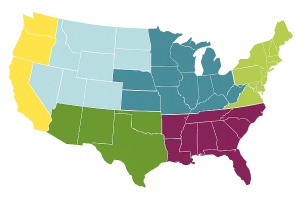Virginia Native Plants, State Flower & State Bird
Posted By American Meadows Content Team on Sep 27, 2012 · Revised on Oct 26, 2025

Knowing your location helps us recommend plants that will thrive in your climate, based on your Growing Zone.
Posted By American Meadows Content Team on Sep 27, 2012 · Revised on Oct 26, 2025
Native plants are adaptable, low-maintenance, and beautiful. They are the best choice for habitat-friendly gardens and thriving ecosystems. Find top picks for native plants in your state - and learn about your state bird and state flowers!
Follow Along With More Of Our Guides
Hello native plant enthusiasts! In the list below, you will find popular native plants and wildflower seeds, available from American Meadows, that have a native distribution in your state. You’ll also find information about your state bird, state flower, and state wildflower!
Grow our Native Southeast Wildflower Seed Mix
Virginia Bluebells (Mertensia virginica) (The State Wildflower!)
Showy Goldenrod (Solidago speciosa)
Wrinkleleaf Goldenrod (Solidago rugosa)
Perennial Lupine (Lupinus perennis)
Black Eyed Susan (Rudbeckia fulgida)
Black Eyed Susan or Gloriosa Daisy (Rudbeckia hirta)
Pale Purple Coneflower (Echinacea pallida)
Gray Headed Coneflower (Ratibida pinnata)
Butterfly Weed (Asclepias tuberosa)
Swamp Milkweed (Asclepias incarnata)
Common Milkweed (Asclepias syriaca)
White Trillium (Trillium grandiflorum)
Red Trillium (Trillium erectum)
Painted Trillium (Trillium undulatum)
White Tinged Sedge (Carex albicans)
Appalachian Sedge (Carex appalachia)
Wild Strawberry (Fragaria virginiana)
Lowbush Blueberry (Vaccinium angustifolium)
Plains Coreopsis (Coreopsis tinctoria)
Lanceleaf Coreopsis (Coreopsis lanceolata)
Wild Bergamot (Monarda fistulosa)
Wild Geranium (Geranium maculatum)
Elderberry (Sambucus canadensis)
Phlox divaricata (Woodland Phlox)
Phlox subulata (Creeping Phlox)
Obedient Plant (Physostegia virginiana)
Red Cardinal Flower (Lobelia cardinalis)
Blazing Star (Liatris spicata)
Meadow Anemone (Anemone canadensis)
Bottlebrush Grass (Elymus hystrix)
Muhly Grass (Muhlenbergia capillaris)
Big Bluestem (Andropogon gerardii)
Little Bluestem (Schizachyrium scoparium)
Tufted Hair Grass (Deschampsia cespitosa)
Northern Sea Oats (Chasmanthium latifolium)
Yellow Prairie Grass (Sorghastrum nutans)
Smooth Blue Aster (Symphyotrichum laeve)
Aromatic Aster (Symphyotrichum oblongifolium)
New England Aster (Symphyotrichum novae-angliae)
Common White Yarrow (Achillea millefolium)
Heliopsis (Heliopsis helianthoides)

Cardinal ~ Richmondena cardinalis
Adult Cardinals remain in a chosen area throughout the winter, but young Cardinals often wander widely during the winter, sometimes in small flocks. At feeding stations, the Cardinals are honored guests, as their red plumage seems doubly bright in the white snow. Even when they have retreated into the backyard shrubbery, they distinguish themselves by spirited song and the characteristic call note, a sharp tsip.
Flowering Dogwood ~ Cornus florida
The Flowering Dogwood is a small tree with spreading branches. Its flowers are very tiny and greenish-yellow, and they grow in compact bunches. In their bud state, during the preceding winter, the group is protected by four small brown bracts which cover them snugly. When the winter is over, these bracts begin to grow and change color, until finally they reach a width of three to four inches and are white or pale pink. Then the inconspicuous true flowers open="open" their four petals for visiting insects. In the autumn, Dogwood foliage turns rich shades of red and its fruit turns a vibrant scarlet.
From The Wildflowers of the 50 States U.S. stamps issued July 24, 1992:

